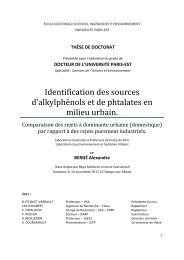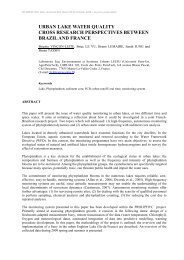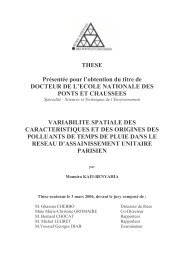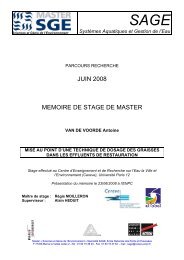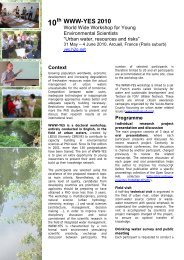View - ResearchGate
View - ResearchGate
View - ResearchGate
You also want an ePaper? Increase the reach of your titles
YUMPU automatically turns print PDFs into web optimized ePapers that Google loves.
4 Safeguarding urban areas confronting climatetrends and extreme weather by means of a transdisciplinaryapproachStaufer, P. *, Siekmann, M. * , Pinnekamp, J. *As seen, the changes of the hydrological cycle of large areas and whole river basins will besevere. When these changes will be investigated in combination with impacts on the hydrologicalcycle that has already been modified by urbanization the outcome will be more hazardous. Theprocesses involved in the hydrological cycle within urban areas react more quickly than those ofpervious areas. Not only hydrological aspects but also water quality will be affected by the givenchanges.* Institute of Environmental Engineering Aachen University (RWTH), Mies-van-der-Rohe-Straße 1, 52074 Aachen, Germany (Corresponding author, e-mailstaufer@isa.rwth-aachen.de)INTRODUCTIONAbstractWith regard to the climate change an increase of storm water events combined withlonger droughts is prognosticated subsequently resulting in growing discharges of sewageinto receiving water bodies with harmful consequences for surfaces water. And second,longer dry weather periods and an increase of the annual average air temperature willproduce a shift of water balance and a decrease of available water resources, withparticular hazard for drinking water supply. Due to the currently foreseeable remodellingof settlement areas - not least activated by the looming population development inGermany and Europe - actions should be taken to counteract the consequences for watermanagement out of the climate trends and the shift of extreme weather statistics. To meetthese challenges an interdisciplinary competence network was formed includingparticipants from urban planning, water resources management, drinking water supplyand social scientists. The interdisciplinary cooperation shall assure that the prognosticatedharmful outcomes on the urban water management not only can be attenuated but also becompensated by sustainable water sensitive methods. This paper deals with a firstassessment of the primary issues, states scenarios to assess the range of change and toovercome lack of information and finally presents matrices containing adaptationmeasures.KeywordsAdaptation; climate change; global warming; residential areas; water sensitive urbandesignImpacts of climate change to the hydrological cycleThe climate change will affect the temperature as well as the frequency, duration and intensity ofstorm water events. The hydrological balance of rivers and watercourses normally will rely onlarge-scale processes in time and space, while urban runoff depends on local storms and need tobe modelled by higher temporal (minutes) and spatial (hectares) resolution.The size of the shift in the water balance, however, differs greatly between the various climatezones of Europe. Nevertheless, the sensitive hydrological cycle is bound to react with- a smaller groundwater recharge and lower groundwater level,- rising water stress in areas which are already confronted with water shortage,- an increase in the number of flooding due to storm water events and- higher fluctuating discharges of water bodies throughout a year as a result of an increase of theoccurrence of flooding (EEA 2007) and longer periods of low river-flows (Figure 1) in summer(EEA 2007, Jacob 2006, Lehner et al. 2001, Middelkoop et al. 2001).Figure 1: Rising number of low flow periods (Q < 750 m³/s) in River Rhine at Gauging station Kaub,Germany, based on the IPCC B2 Scenario (Jacob, 2006)Migration, population and demographic changesUrban planning as well as all infrastructure systems are designed for a certain population. If thepopulation exceeds the infrastructures, e.g. water supply system or sewerage, has to be expanded.At least in European countries enlarging a given system is possible, because population growthgoes together with economic growth. In contrast, at the centre of the current debate about futureEuropean water infrastructure systems more and more the decline of consumption as a result ofdeclining populations is discussed, which often goes together with shifts in consumption patternsand reindustrialisation. This is a considerable driving force in the transformation processcurrently taking place in the water sector (Libbe and Moss 2006).As much as we have to welcome a trend of saving water due to technical innovation, risingprices etc., with regard to environmental aspects, the consequences for the infrastructure systemsare great, dimensioned on increasing demand and mass flow rate (Schiller and Siedentop 2005).Because of the longer amount of time that water and wastewater stay in the pipelines, there aredeficits regarding the quality, transmissibility, odours, and corrosions as well as increasingdeposits. If deposits are remobilised during storm water events, combined sewer overflows andwastewater treatment plants emit higher pollution loads into the receiving water bodies.Furthermore, the infrastructure system is featuring an extremely long-term economical andtechnical lifecycle. The security connected with this comes with a path dependency and lack offlexibility of the system. With a decrease in the average utilisation but increasing operating costsa pitfall of fixed costs will occur: In order to generate the large fixed costs, higher unit priceshave to be charged by fewer consumers. This will not only lead to a further fall in theconsumption of water it also has a not to underestimate socio-political implication in structurallyweak areas. The apportionment to the consumer is only partly politically enforceable.Local FocusWWW-YES 2008, Paris 13 – 16 May 2008 33WWW-YES 2008, Paris 13 – 16 May 2008 34



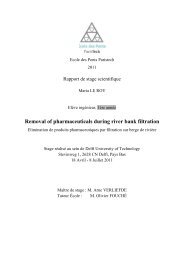
![[pastel-00730831, v1] Incidence des pratiques d'entretien ... - LEESU](https://img.yumpu.com/50938896/1/184x260/pastel-00730831-v1-incidence-des-pratiques-dentretien-leesu.jpg?quality=85)

